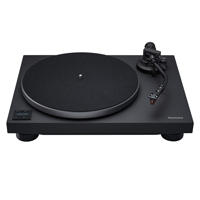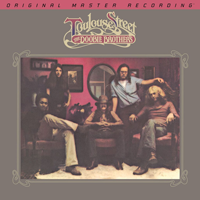PrimaLuna EVO 100 Tube DAC
Full Details
Dare to Be Different: PrimaLuna EVO Tube DAC Features World's First Tube-Based Data-Clocking Device (SuperTubeClock), Dual-Mono Topology, Tube-Rectified Power Supply, and High-Res USB Input
Looking for a DAC unlike any other on the market and that out-classes many models that have a higher list price? Get familiar with the PrimaLuna EVO 100 tube DAC. It employs the world's first tube-based data-clocking device — the trademarked SuperTubeClock, which incorporates a low-noise mini-triode vacuum tube into the digital clock — instead of the solid-state oscillator usually found in value DACs. This approach dramatically lowers jitter and noise, enhances detail retrieval, and reveals increases in top-to-bottom detail and dynamics. Who could argue with that?
Read more about the SuperTubeClock below, but for the time being, know that EVO 100 sports dual-mono topology with per-channel dedicated tubes; a tube-rectified power supply with 11 separate regulation circuits; dual toroidal power transformers; high-grade output transformers; and a Burr-Brown PCM1792A DAC. Audiophile parts throughout — including polypropylene coupling caps, triple pi power-supply filters, and custom isolation transformers that separate the analog and digital components — as well as point-to-point wiring throughout the entire signal path put another exclamation point on this standout piece of kit. No wonder EVO 100 weighs in at nearly 29 pounds — triple the weight of most DACs.
Equipped with a truly high-resolution USB digital input that converts the jitter-filled USB signal to S/PDIF to improve the signal before it reaches the SuperTubeClock, EVO 100 supports DSD128 and 24-bit/192kHz PCM. Measuring 7.5 x 11 x 15.9 inches (HWD), EVO 100 comes with a pair of RCA outputs plus one AES/EBU, coaxial, and optical input each. Boasting six tubes in total, it also has another PrimaLuna exclusive in the form of an AC Offset Killer. Ut lowers transformer noise to a level you need to hear to believe — and you will, especially when you experience the elevated degrees of spaciousness, black backgrounds, and natural decay that result.
Sold with a remote control and three-year manufacturer warranty, EVO 100 continues to rack up acclaim from music lovers around the globe. Speak with a Music Direct audio consultant at 312-433-0200 to learn more.
“With sweet, accurate midrange sonics and sturdy construction that should last a long time, this mid-priced tube DAC has a stout tube-rectified power supply for each channel. While that’s unusual for a DAC, it assures dynamic range will be wide and dynamic shifts lightning fast."
— Vade Forrester, The Absolute Sound, Editors' Choice Award
“To say that I’m staggered by the EVO 100 is understatement, primarily because I wasn’t expecting such undeniable musicality. This DAC has such a genteel way with whatever signal is fed to it that you’ll be listening for hours longer than intended. It’s an exercise in quality, usability, and performance versus features and bling."
— Ken Kessler, Hi-Fi News
"The experience was absolutely holographic, cinematic even... The EVO sounds so analog-like that I haven’t touched my turntable since it’s been here.”
— Sean Zloch, TONEAudio, Exceptional Value Award
“You just hear a refinement and sophistication to the sound that is so hard to find in audio today.”
— Alan Sircom, Hi-Fi+
"The PrimaLuna EVO 100 Tube DAC, a blockbuster component and musical triumph, leapfrogs dozens of DACs to virtually achieve state-of-the-art definition at a more than reasonable cost. Built as an heirloom product, this tubed beauty will bring you a lifetime of enjoyment from all the digital sources I can imagine."
— Robert Levi, Positive Feedback
"Built around a BurrBrown DAC and upsampler partnered with a unique valve oscillator, the EVO 100 combines a useful selection of inputs, comprehensive sample rate support, and sturdy build with a unique sonic performance."
— Ed Selley, HiFi Choice
SuperTubeClock
First a note on the tube itself: It is a very rugged, long-life Russian military triode specifically designed for oscillation purposes. Exactly its function in EVO 100. Life expectancy is roughly 5 to 10 years of operating time. The small glass envelope guarantees very low microphonics. Triode tubes are inherently low noise devices, and extremely linear when used properly. This means that the oscillation frequency wave it produces is very pure and clean. The noise in the sidebands, from 10Hz to 100kHz on either side of the oscillation frequency, is extremely low. Everything below and beyond that can be ignored.
When you re-clock the inputs, any noise generated here appears unfiltered and unattenuated at the input of the conversion chip, and injects jitter, which from then on is an indistinguishable part of the digital audio stream. No amount of cleaning will ever be able to remove this noise once it reaches this point; it becomes part of the audio signal. This noise "rides" on the audio signal so you do not hear it as noise, but as smearing of notes and masking of detail. There is a distinctive loss of dynamics, tonal purity, inter-transient silence, and sense of timing. We call this "noise modulation." This is why the low noise, especially in the 10Hz-100kHz sidebands of the oscillator, is so crucial. Again: Below and beyond these frequency extremes is trivial since it will not affect the audio, and will not reach the analog outputs.
When the clock is used to clock the DAC chip, a similar situation occurs as described above: the noise appears at the location where the digital audio stream is converted to successive steps in a staircase wave, which represents the analog audio signal. Each step has to be exactly 1/441000th, 1/96000th, 1/176400th, or 1/192000th. The injected noise introduces a deviation in time that is the exact replica of that noise. This means the audio signal at the outputs of the DAC chip has the noise riding on it, again as an inherent part of the signal. No amount of filtering will remove the noise once it reaches this step. Again, you experience that smear and detail masking, with a distinctive loss of dynamics, tonal purity, inter-transient silence, and sense of timing. This is why re-clocking both the inputs and the DAC chip makes complete sense.
The oscillation frequency wave produced by a tube is a sine wave. That's no good; it has to be converted to a square wave. When the rising and falling edges of a square wave are not steep enough, a certain window exists during which the actual transition of the data bit is not exactly time-defined. It leaves room to be either too late or too early. This is a partly random process, and partly dependent on surrounding conditions such as power supply voltage variations, ground noise, inherent CMOS or chip crosstalk in the decoder or DAC chip, etc. All these timing variations are noise, and are called jitter from various sources. The steeper the edges, the more exactly defined the transition moment will be, resulting in less noise (jitter). When a clock produces a very stable frequency with such low jitter, there will be a more accurate reproduction of the original analog waveform of the music.
For illustration purposes, imagine the SuperTubeClock generating a square wave at 8.4672MHz. The vertical slope is measured at ~500mV. The vertical peak-to-peak travel of the square wave at this frequency is 3.5 Volts, which is excellent. The faster a clock can go from peak to peak, the better. Square waves present themselves more and more like sine waves the higher you go in frequency. So, an 8.4672mHz wave is still identifiable as a square wave, but as you approach 42.2mHz, a square wave will be almost fully rounded off and appear as a sine wave. As a square wave begins to round off, it means the timing of the digital transmissions has become more insecure, allowing for the introduction of more noise and jitter that is then presented to the DAC.
Now, let's turn to a square wave generated by the SuperTubeClock at 42.2MHz. The square wave still has a very discernible square shape. This means the clock is very fast, leaving very little time to introduce jitter and noise that can interfere with sound quality as mentioned above. As seen on a scope, each black vertical line running from left to right represents five nanoseconds. The time it takes the slope to go from the top bar to the bottom takes up roughly 1/3 of that black square, which is about 1.67 nanoseconds. In other words, 1.6 billionths of a second. Each black horizontal line in this measurement represents ~1V from top to bottom. Just as in the first wave above, the peak-to-peak travel at 42.MmHz is about 3.6 volts. This kind of speed is crucial to ensure accuracy in detail retrieval. This in turn introduces less noise and jitter, resulting in better transients, increased clarity, improved dynamics, and a pure, musical tonality.
Specifications
- Inputs: USB, AES/EBU, Coax, Optical
- Outputs: Stereo RCA
- PCM (all inputs): 16bit-24bit, 44.1kHz-192kHz
- DSD (USB): DSD64-DSD128 (DoP)
- DSD (other inputs): DSD64 (DoP)
- DAC: TI (Burr Brown) PCM1792A
- 24bit/192kHz Upsampling: TI (Burr Brown) SRC4192
- Tube Complement: 2 - 12AX7, 2 - 12AU7, 2 - 5AR4
- Dimensions (W x H x D): 11" x 7.5" x 15.9"
- Weight: 28.7 lbs






































